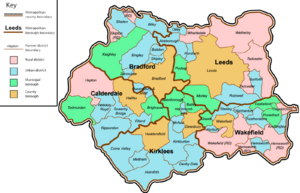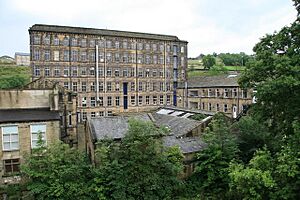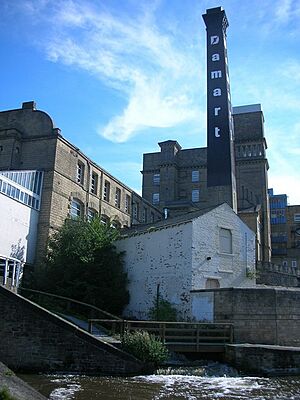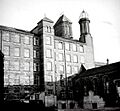List of mills in Bradford (metropolitan borough) facts for kids
Imagine a time when huge factories, called textile mills, were the heart of many towns! This article is about the many wool, cotton, and other textile mills that once thrived in the City of Bradford, a large area in West Yorkshire, England. This includes towns like Bradford itself, Keighley, Baildon, Bingley, Denholme, Ilkley, Queensbury and Shelf, Silsden, and Shipley.
We'll also look at mills in Skipton, which was historically part of the West Riding of Yorkshire but is now in North Yorkshire. These mills were super important for making clothes and fabrics, especially during the time of the Industrial Revolution.
Contents
What were Textile Mills?
Textile mills were factories where raw materials like wool or cotton were turned into yarn and then into fabric. They were often large buildings, sometimes with tall chimneys, and they used powerful machines to do the work. Before mills, people often made textiles by hand in their homes. But with new inventions, mills could produce much more fabric, much faster!
Why were Mills Important to Bradford?
Bradford became famous as the "wool capital of the world" because of its many mills. The area had lots of soft water, which was perfect for washing wool. It also had coal for powering steam engines and good transport links. This made it a perfect place for the textile industry to grow. Thousands of people worked in these mills, and they helped make Bradford a very rich and important city.
Famous Mills and Their Stories
Many mills in the Bradford area have interesting histories. Some were huge and employed many people, while others were smaller. They all played a part in the region's textile story.
Saltaire Mills: A Special Village
One of the most famous mills is Saltaire Mills in Shipley. It was built by Sir Titus Salt in the 1850s. He didn't just build a mill; he built an entire village for his workers! This village, called Saltaire, had homes, a school, a hospital, and even a park. Sir Titus wanted his workers to have good living conditions, which was quite unusual for that time. Saltaire is now a UNESCO World Heritage Site, meaning it's a very important historical place.
Ebor Mill in Haworth
Ebor Mill in Haworth is another interesting example. It was an "integrated worsted factory," which means it handled all the steps of making worsted fabric, from raw wool to finished cloth. It started around 1819 and had a large building added in 1887. It was first powered by water, then by steam. It even has a very cool, tall chimney!
Bowling Green Mills in Bingley
Bowling Green Mills in Bingley, sometimes known as Damart Mill, is another historic site. Its engine house and chimney are so important that they are listed as Grade II listed buildings. This means they are protected because of their special historical or architectural value.
Where Were the Mills Located?
The mills were spread out across the region, often near rivers or canals that provided water power and transport. Here are some of the main areas where they were found:
Baildon Mills
Baildon had several mills, including Baildon Mills, Charlestown Mill, and Lower Holme Mills. These mills helped the town grow and provided jobs for many local families.
Bingley Mills
Bingley was home to many mills along the River Aire, such as Airedale Mills, Angora Mill, and Britannia Mills. The textile industry was a huge part of Bingley's history.
Haworth Mills
Haworth, famous for its connections to the Brontë sisters, also had a number of mills like Ashmount Mills and Bridge Mill. These mills were important for the local economy.
Keighley Mills
Keighley was another major mill town, with many factories like Aireworth Mills, Dalton Mills, and Devonshire Mills. The sound of looms and steam engines would have filled the air here.
Shipley Mills
Besides Saltaire Mills, Shipley had other important mills like Airedale Mills and Hirst Mill, showing how vital the textile industry was to this area.
Skipton Mills
Even though Skipton is now in North Yorkshire, it was historically part of the West Riding and had mills like Belle Vue Mills and Union Mills, contributing to the wider textile story of the region.
The End of an Era
Over time, the textile industry in Britain changed. Many mills closed down as production moved to other countries or as new technologies emerged. Today, many of these old mill buildings have been given new life. Some are apartments, offices, or even museums and art galleries. They stand as a reminder of a very important part of British history and how people lived and worked in the past.
Images for kids
See also
- Heavy Woollen District
- Textile processing








